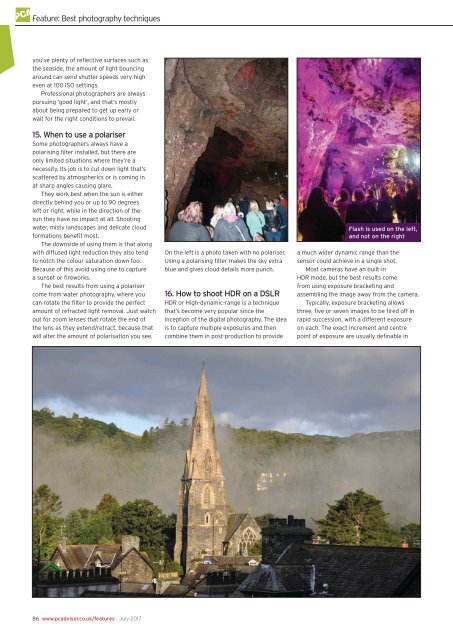You also want an ePaper? Increase the reach of your titles
YUMPU automatically turns print PDFs into web optimized ePapers that Google loves.
Feature: Best photography techniques<br />
you’ve plenty of reflective surfaces such as<br />
the seaside, the amount of light bouncing<br />
around can send shutter speeds very high<br />
even at 100 ISO settings.<br />
Professional photographers are always<br />
pursuing ‘good light’, and that’s mostly<br />
about being prepared to get up early or<br />
wait for the right conditions to prevail.<br />
15. When to use a polariser<br />
Some photographers always have a<br />
polarising filter installed, but there are<br />
only limited situations where they’re a<br />
necessity. Its job is to cut down light that’s<br />
scattered by atmospherics or is coming in<br />
at sharp angles causing glare.<br />
They work best when the sun is either<br />
directly behind you or up to 90 degrees<br />
left or right, while in the direction of the<br />
sun they have no impact at all. Shooting<br />
water, misty landscapes and delicate cloud<br />
formations benefit most.<br />
The downside of using them is that along<br />
with diffused light reduction they also tend<br />
to notch the colour saturation down too.<br />
Because of this avoid using one to capture<br />
a sunset or fireworks.<br />
The best results from using a polariser<br />
come from water photography, where you<br />
can rotate the filter to provide the perfect<br />
amount of refracted light removal. Just watch<br />
out for zoom lenses that rotate the end of<br />
the lens as they extend/retract, because that<br />
will alter the amount of polarisation you see.<br />
On the left is a photo taken with no polariser.<br />
Using a polarising filter makes the sky extra<br />
blue and gives cloud details more punch.<br />
16. How to shoot HDR on a DSLR<br />
HDR or High-dynamic-range is a technique<br />
that’s become very popular since the<br />
inception of the digital photography. The idea<br />
is to capture multiple exposures and then<br />
combine them in post-production to provide<br />
Flash is used on the left,<br />
and not on the right<br />
a much wider dynamic range than the<br />
sensor could achieve in a single shot.<br />
Most cameras have an built-in<br />
HDR mode, but the best results come<br />
from using exposure bracketing and<br />
assembling the image away from the camera.<br />
Typically, exposure bracketing allows<br />
three, five or seven images to be fired off in<br />
rapid succession, with a different exposure<br />
on each. The exact increment and centre<br />
point of exposure are usually definable in<br />
86 www.pcadvisor.co.uk/features <strong>July</strong> <strong>2017</strong>


















